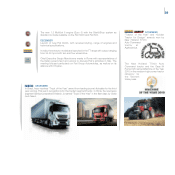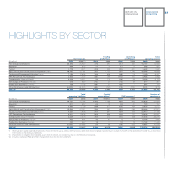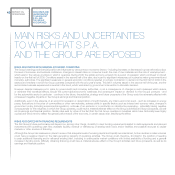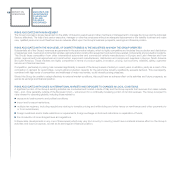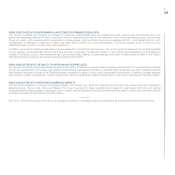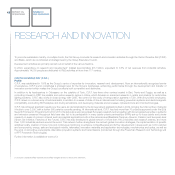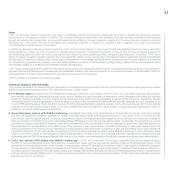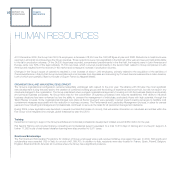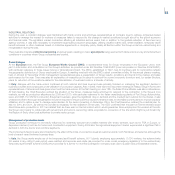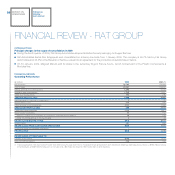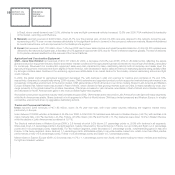Chrysler 2009 Annual Report Download - page 50
Download and view the complete annual report
Please find page 50 of the 2009 Chrysler annual report below. You can navigate through the pages in the report by either clicking on the pages listed below, or by using the keyword search tool below to find specific information within the annual report.
49
Again for the purpose of reducing emissions, and also to comply with the EU regulation which bans, beginning in 2011, use of the current refrigerant
R134a in favour of fluids with a lower greenhouse effect, C.R.F. has, as part of the European TOPMACS project, developed an air-conditioning system
that works with heat recovered from the engine cooling system to power a heat pump based on the adsorption of liquids on a solid matrix. This system,
powered by a solar panel or heat from a type of boiler already used in some vehicles as an auxiliary heater, provides air conditioning even when the
engine is off, enabling the vehicle interior to be pre-air-conditioned or, for large commercial vehicles, actually enabling the cabin to be air-conditioned
during overnight stops. Finally, C.R.F. continued research and development of heat conversion systems, based on a variety of technologies, that can be
integrated into the engine and vehicle systems.
Other research related to the use of nanotechnology to improve the efficiency of heat recovery from exhaust gases and conversion into electricity.
Advanced vehicles, materials and processes
The objective is to improve the environmental performance of vehicles and the vehicle manufacturing process through the development of economically
sustainable product and process solutions.
The most significant achievements in this area during 2009 include:
Materials for lighter vehicles. In 2009, the prototype of a light body shell was unveiled at Wolfsburg, the final result of the European SuperLightCar
project, in which C.R.F. and Comau jointly developed the assembly process for the concept car, reconciling technological feasibility and product engine-
ering for mass production.
The challenging objective for this four-year project, coordinated by Volkswagen with the participation of 38 partners (including the main European
OEMs), was to reduce the weight of a standard body shell by 35%, which was achieved through extensive use of multi-material structures based on the
performance and stylistic characteristics required: high-resistance steel, aluminium, magnesium (both in cast and sheet form) and thermoplastics (pressed
and pultruded) combined using innovative welding, adhesive bonding and mechanical joining technologies.
Environmentally friendly and recycled materials. In 2009, C.R.F. continued in its commitment to evaluate the environmental impacts and, in
particular, the carbon footprint of designing and producing plastic components for interiors. Testing started on moulding biopolymers - polymers obtained
from renewable sources (green chemicals) rather than petrochemicals, enabling a significant reduction in CO2 emissions - while testing continued on
components for vehicle interiors made out of plastics reinforced with natural fibres and new tests were launched to explore the feasibility of using recycled
plastics from end-of-life vehicles, such as polypropylene from bumpers and rubber dust from tyres.
Highly energy-efficient production processes. C.R.F. continued the “Green Factories” project whose objective is to develop models for analysing
and optimising the energy efficiency of production processes. An analysis was conducted on the following plants: Automotive Lighting Italia (Venaria),
Fiat Group Automobiles Mirafiori (Turin) and FPT Powertrain Technologies (New Engine Family Iveco, NEF, Turin). At each site, concrete opportunities
were identified to reduced energy consumed by production processes through, for example, optimised control of machine operating cycles and the most
appropriate tooling (in the case of NEF). The issue was also addressed through the European Next project, which saw development of the first models
and instruments for predicting energy consumption of machinery and the environmental impact throughout their life cycle. Measures to improve existing
processes were accompanied by a study of new processes as alternatives to those with the highest levels of energy consumption, such as painting. In
this area, C.R.F. is a participant in the European MUST project, which aims to decrease energy consumption by reducing painting cycles through the use
of special primer treatment or cataphoresis with nano-additives.
Micro and nanotechnologies for environmentally-friendly manufacturing. Again with a view to reducing energy consumption at plants, C.R.F.
worked on the targeted use of micro- and nanotechnologies to maximise energy efficiency and achieve savings. For lighting, research looked at high-
efficiency optical solutions based on high-output LED sources, while the positioning of LED sources and their ground lighting profile was optimised
based on user requirements. For thermoelectric systems, innovative materials were employed to convert thermal energy directly into electricity to
recover waste heat from thermal processes. Lastly, the potential for recovering vibrational and photoelectric energy to power local electronic devices
was evaluated. This technology also enables construction of networks of wireless sensors which can be used to enhance energy management for
each individual stage of a process.


